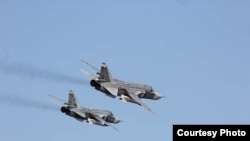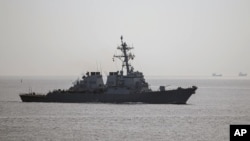Several Russian military aircraft flew a series of simulated attack passes near a U.S. destroyer in the Baltic Sea over the course of two days this week, a U.S. defense official said.
The first of the two incidents, which the U.S. official called “more aggressive than anything we’ve seen in a long time,” took place April 11. Two Russian attack aircraft flew around 20 passes near the USS Donald Cook, coming within 1,000 meters at 30 meters in altitude – close enough to create a wake in the water.
The following day, the warplanes did 11 more simulated attack passes just nine meters above the Donald Cook. This time, the jets were joined by a military helicopter that took pictures of the U.S. destroyer.
Watch video provided by U.S. Navy:
Both incidents took place while the Donald Cook was located in international waters.
The official, who spoke on the condition of anonymity, described the aircraft as “wings clean,” which means they didn’t have any visible weapons.According to the official, sailors aboard the ship attempted to reach the Russian planes by radio, but there was no response.
At the time of the incident, the Donald Cook was positioned off the coast Kaliningrad – a Russian territory on the Baltic coast between Lithuania and Poland.
“The commanding officer [of the Donald Cook] – his assessment was that this was unsafe and unprofessional,” the U.S. official said. He said a formal U.S. military review of the incident is underway.
At a briefing Wednesday, White House spokesman Josh Earnest echoed those sentiments, calling the incident “entirely inconsistent with professional norms of militaries.”
Earnest said the White House continues to be concerned about repeated incidents over the past year of Russian jets flying too close to U.S. ships in international waters.
"We have seen a pattern on the part of the Russians in undertaking these kinds of actions that they at least intend to be provocative," he said. "They are a source of some irritation. That is something that we have expressed both privately and publicly to the Russians."
The Donald Cook had just come from a port visit in Gdynia, Poland, when the flyovers occurred. It was headed out to sea with a Polish helicopter on board.
NATO has been asked to provide a permanent presence of battalion-sized deployments of allied troops in the Baltic states. A NATO battalion typically consists of 300 to 800 troops.
Moscow denies any intention to attack the Baltic states.
VOA national security correspondent Jeff Seldin contributed to this report.






